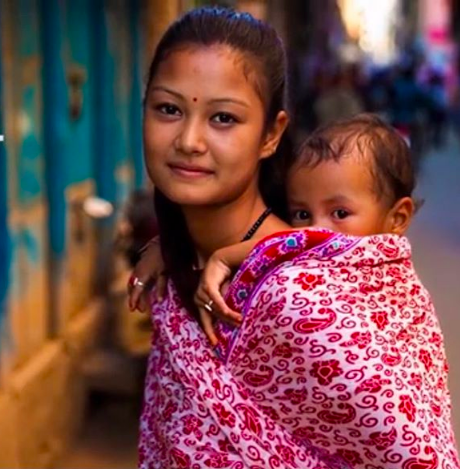Many people will be aware of the current discussions around social justice and cultural appropriation taking place in much of the babywearing world, which is part of the wider ongoing worldwide struggle for equity and fairness for all peoples. Cultural appropriation, from what I understand, is about power imbalances and marginalised or indigenous cultures being “used” for increased profit for the privileged. They are usually left out of the business model, meaning they do not see any return or profit for their work being sold. Social justice matters; it is an oppressive practice to take the meaningful images and representations of a culture to make cute objects (which can include baby carriers) for the privileged to enjoy. An example of this would be the widespread use of First Nations head-dresses and symbols in fabrics, clothing, toys, logos and sporting names. First Nations people are still enduring oppression and racism, and fighting for respect and recognition. Using their cultural symbols without permission or credit is disrespectful, and they should be the people who benefit financially from any commodification of their culture. Read more here.
I need to say that firstly, it is not my place to define what is or isn’t cultural appropriation when it comes to particular examples of fabric design or weaving. Legitimate voices (including those who are directly impacted) are expressing many different viewpoints on this in other forums, and it is their perspectives that matter. I urge you to engage in the dialogue about social justice, go and find all these widely differing views, find out as many facts as possible from as many perspectives as possible, and listen, and then listen some more.
I am here to discuss the origins of child-carrying and “babywearing”, as many people have begun to ask if the act of carrying their children is somehow wrong or damaging to minority cultures – are they being oppressive by wrapping their children or carrying them in any form of sling?
On the simplest level, carrying children is normal biological human behaviour, for safety, for nourishment, for nurture. The bodies of mothers and children are adapted to carry and be carried. Babies are born in a very vulnerable state, needing intense nurturing and care, thus the mother’s body is the baby’s home for the “fourth trimester” of their lives. You can read more about this in the references below.

Using tools to make children easier to carry while life goes on is what human beings around the world do to make life workable. Anthropologists (such as Timothy Taylor) postulate that our early ancestors will have utilised some sort of tool for carrying, to allow an increased range of movement; and therefore facilitated long distance migration across continents with babies in arms. Isolated tribes with no references to the outside world fashion items to transport children in. Cultures across the globe carry children in many forms of carrier that have been developed within their own communities.
Therefore, the act of carrying a child in a carrier cannot be, in and of itself, oppressive or wrong in any way. Carrying matters. We should ALL carry our young children somehow, be it in arms or in a sling; they need to be close to us to thrive. Mothers and fathers and caregivers instinctively hold their children; a tool to make this easier and promote the building of bonds as well as convenience is to be welcomed. This is especially important in the current prevailing Western attitude to families that seems to promote detachment from children and early separation at great cost to future mental health.
Europeans do indeed have their own carrying cultures: the plaid in Scotland, the cwtch in Wales, the hockmantel in Germany, to name just a handful. The book Beloved Burden discusses more. However, Europeans by and large, lost their culture of carrying due to all sorts of factors (such as the Industrial Revolution, changing philosophies of productivity and the mores of the Victorian era). Carrying children in cloths became something for poorer families to do, and it mostly passed into history, to the great detriment of our society.
I am grateful to the indigenous cultures around the world who never lost this important skill and who have continued to carry. I am grateful that we in the UK are now able to enjoy these tools, helping to build a more caring, responsive and healthy society. It matters that these cultures who have shared their wisdom with us are not forgotten. I cringe when I hear people talking about “discovering babywearing”, as this couldn’t be further from the truth. There are many. many complex threads of discussion regarding how some indigenous practices of child carrying in cloths has contributed to our modern wrapping culture and the mechanisms by which they arrived. I will not go into these here; as I do not know the full stories in depth. Again, I urge you to read widely on all fronts and listen to all voices. Skilled translators will no doubt help with the unpacking of this complex issue.
So, while carrying children in various tools itself isn’t wrong, I think it is good and wise to be aware of the potential issues. Some items used for carrying are indeed problematic, for example by the choice of imagery, or by the names chosen for them. Some have brought great distress to groups of people. This may have been unwitting at the time, however, in today’s more socially aware climate, companies would be wise to be responsive to concerns being raised, and make conscious choices to behave in an ethical and socially responsive way. This could be in the business models they choose, how they pay their workers, how they create or credit designs, how they market them, how they engage with their customers and how they react to the raising of problems.
What next?
Please do not feel you need stop carrying your child in your sling, or worry that you are somehow being oppressive by using it. You bought your sling to keep your child close and it still serves that valuable purpose.
If, as you immerse yourself in the babywearing culture, you discover something about your sling that makes you uncomfortable, that does not make you personally culpable, in my view. Choosing what to do with it next is up to you; this carrier may have brought you and your child many happy moments and these memories are still precious and valid. Once you know about the issues, and have learned more about the background, it is up to you to act in a way that sits right with your conscience and doesn’t minimise or dismiss other people’s distress. Do ask your local sling community and professionals for support and advice if you need it, and find out what others have done with theirs. Personally, any carriers in my sling library that have been found to be problematic will remain in my library as teaching and borrowing tools, bringing good to babies. If I am asked about issues, I will share what I know.
It is important to keep eyes on all perspectives; parents new to slings may not be aware of such issues yet and are simply seeking to build a family bond, or find a way to make their lives work, or comfort their unhappy baby. It is important that new parents are not “put off” babywearing by important debates such as these; this would be a great loss to their future, to our communities and to the mental health of our already damaged society that behaves in such selfish ways. I believe that no parent and no carrying community would wish this to happen as the industry seeks to untangle many of the complex issues that are deeply woven into its fabric. These include issues of accessibility and inclusivity as much as diversity. Those of us in educational and teaching roles should be working towards a truly accessible community that welcomes everyone.
To do this, I believe we all need to listen with compassion to all the voices asking to be heard; not just some, or those that we feel align most with our previously held views. Some voices may take time to appear and can change the discussion once again. Voices that have been silenced in the past may need to shout louder to be heard; rather than asking them to behave more nicely, we, with the privileged and/or able positions we inhabit, should recognise distress and listen. Change can only come about with some discomfort, and I think we should all be willing to be challenged and grow, rather than shrink back into defensive reactions. We can ask people what we can really do to help, to bring about real change that makes a difference, and that lasts.
I hope that our industry can work through the current painful challenges it is facing, and end up stronger for taking the time to listen to multiple points of view. This will help us to work out the most sustainable and compassionate way of being that brings the greatest good to the many diverse families of the world.
References
A Baby Wants to be Carried, Evelyn Kirklionis, Pinter and Martin, 2014
Why Babywearing Matters, Rosie Knowles, Pinter and Martin, 2016
Beloved Burden, Babywearing around the World, I.C. Van Hout, 2008


